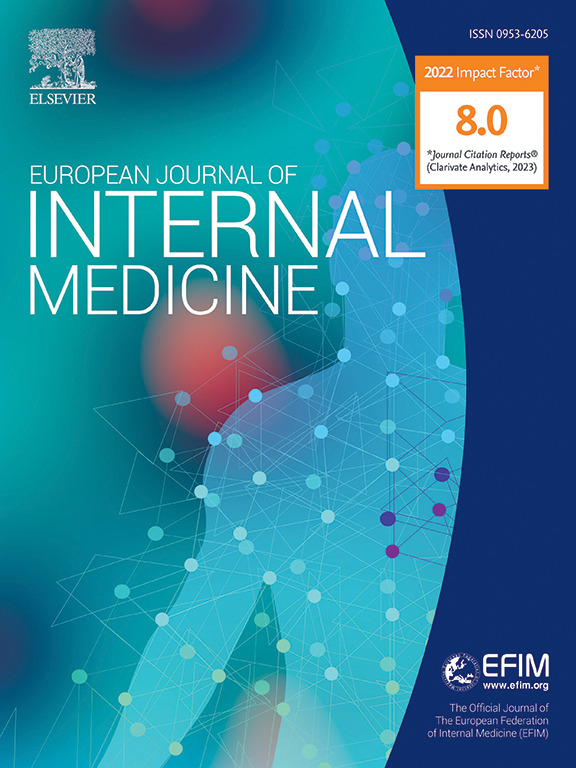Evolution and outcomes of aortic dilations in giant cell arteritis
IF 5.9
2区 医学
Q1 MEDICINE, GENERAL & INTERNAL
引用次数: 0
Abstract
Objectives
To identify factors associated with the progression of giant cell arteritis (GCA)-related or associated aortic dilations.
Methods
In this retrospective study, 47 GCA patients with aortic dilation were longitudinally analyzed. Each patient underwent ≥2 imaging scans of the aorta during the follow-up. Three progression statuses of aortic dilations were distinguished: fast-progressive (FP) defined by a progression of the aortic diameter ≥5 mm/year or ≥1 cm/2 years, slow progressive (SP) by a progression of the aortic diameter >1 mm during the follow-up, and not progressive (NP) when aortic diameter remained stable.
Results
Among the 47 patients with aortic dilation, the thoracic section was involved in 87 % of patients. Within a total follow-up of 89 [6–272] months, we identified 13 (28 %) patients with FP dilations, and 16 (34 %) and 18 (38 %) patients with SP and NP dilations, respectively. No differences regarding baseline characteristics, cardiovascular risk factors or treatments were observed among the 3 groups. However, FP patients more frequently showed atheromatous disease (p = 0.04), with a more frequent use of statins (p = 0.04) and antiplatelet agents (p = 0.02). Among the 27 (57 %) patients with aortitis, aortic dilation developed on an inflammatory segment in 23 (85 %). Among the FP patients who underwent aortic surgery with available histology (n = 3), all presented active vasculitis.
Conclusion
This study suggests that aortic inflammation, as well as atheromatous disease, might participate in the fast progression of aortic dilation in GCA.
巨细胞动脉炎主动脉扩张的演变和结果。
方法在这项回顾性研究中,对 47 名主动脉扩张的 GCA 患者进行了纵向分析。每位患者在随访期间接受了≥2次主动脉成像扫描。主动脉扩张有三种进展状态:快速进展(FP)指主动脉直径进展≥5毫米/年或≥1厘米/2年;缓慢进展(SP)指随访期间主动脉直径进展>1毫米;非进展(NP)指主动脉直径保持稳定。在89个月[6-272]的随访中,我们发现13例(28%)患者为FP扩张,16例(34%)和18例(38%)患者为SP和NP扩张。三组患者的基线特征、心血管风险因素或治疗方法均无差异。不过,FP 患者更常出现动脉粥样硬化疾病(p = 0.04),更常使用他汀类药物(p = 0.04)和抗血小板药物(p = 0.02)。在 27 名(57%)主动脉炎患者中,23 名(85%)患者的主动脉扩张发生在炎症部位。结论本研究表明,主动脉炎症和动脉粥样硬化性疾病可能参与了 GCA 主动脉扩张的快速进展。
本文章由计算机程序翻译,如有差异,请以英文原文为准。
求助全文
约1分钟内获得全文
求助全文
来源期刊
CiteScore
9.60
自引率
6.20%
发文量
364
审稿时长
20 days
期刊介绍:
The European Journal of Internal Medicine serves as the official journal of the European Federation of Internal Medicine and is the primary scientific reference for European academic and non-academic internists. It is dedicated to advancing science and practice in internal medicine across Europe. The journal publishes original articles, editorials, reviews, internal medicine flashcards, and other relevant information in the field. Both translational medicine and clinical studies are emphasized. EJIM aspires to be a leading platform for excellent clinical studies, with a focus on enhancing the quality of healthcare in European hospitals.

 求助内容:
求助内容: 应助结果提醒方式:
应助结果提醒方式:


